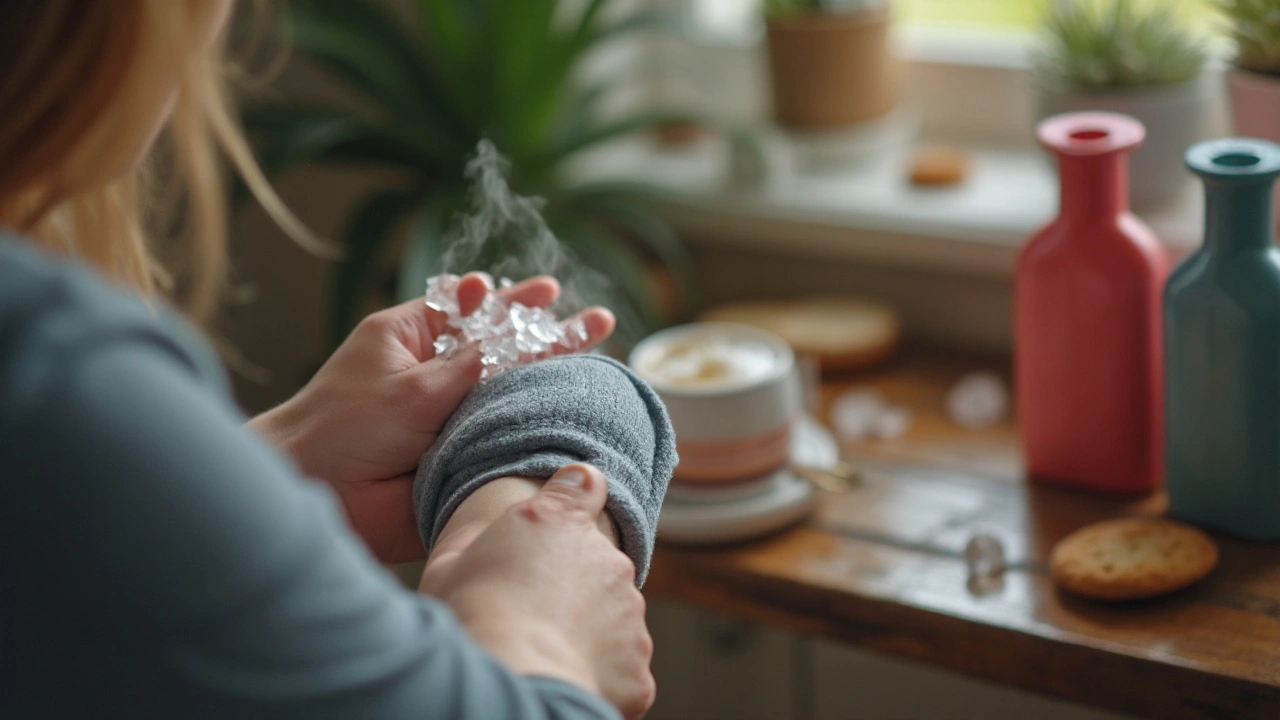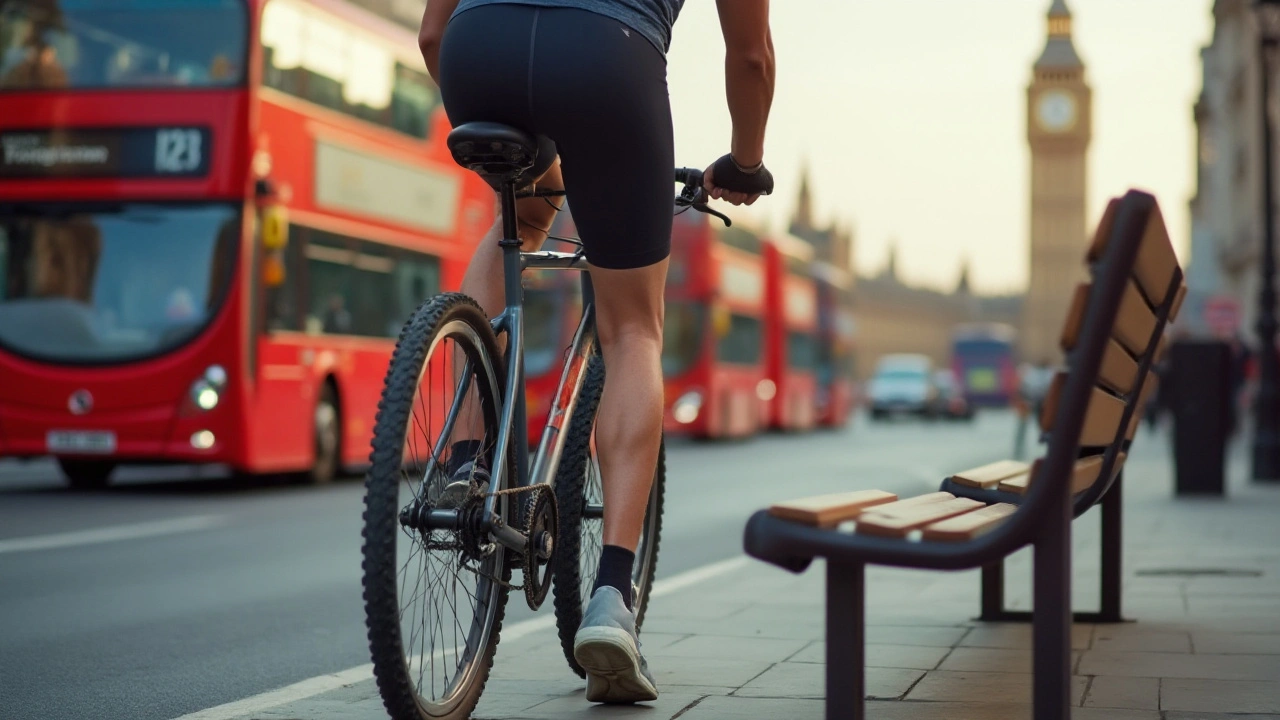Muscle spasms often spring upon us unexpectedly, causing discomfort and hindering our ability to move freely. Finding relief can be a priority when grappling with this issue. Heat and cold therapy are two tried-and-true methods that many find beneficial for easing muscle tension and pain.
Each method works in its unique way to address the issues at hand. Heat therapy relaxes tight muscles, enlarging the blood vessels and increasing blood flow, which aids in healing. On the flip side, cold therapy numbs sharp pain and reduces inflammation, making it particularly helpful after acute injuries.
But when should you use heat, and when should cold be your go-to? Learn about how each method helps and get insight into how best to apply these therapies for maximum benefit. Knowing the right approach can sometimes be all it takes to reclaim your comfort and mobility.
- Understanding Muscle Spasms
- Benefits of Heat Therapy
- Benefits of Cold Therapy
- Practical Tips for Effective Therapy
Understanding Muscle Spasms
Muscle spasms, often dubbed as charley horses when they occur in the legs, are unexpected contractions that can cause a great deal of discomfort or even pain. These involuntary contractions can affect anyone, regardless of age or lifestyle, and they tend to strike when you least expect them. While sometimes fleeting, the discomfort they bring can be sharp or even crippling. This mysterious muscle movement is your body's way of responding to overuse, dehydration, strain, or an imbalance in minerals such as potassium, calcium, and magnesium. Such spasms remind us our bodies require careful tending. Taking into consideration these varied causes, it's no wonder the path to prevention and relief can take different directions depending on the individual.
According to a study published in the Journal of Neurology, muscle spasms affect nearly 60% of adults at some point in their lives. What makes them so challenging is their unpredictability – they can strike while you're sitting, walking, or even in the middle of your restful slumber. Muscle spasms often manifest in the back, legs, or feet, but other muscle groups aren't exempt. These spasms can last anywhere from a few seconds to several minutes, leaving muscles sore and tender to the touch. To truly understand these spasms, experts believe that maintaining the balance between muscle tension and relaxation is key. This delicate balance, influenced by factors such as physical activity level, hydration status, and even stress, highlights why a one-size-fits-all solution is hard to come by.
Research indicates that those who exercise regularly may experience more frequent muscle spasms when their bodies are not adequately replenished with necessary electrolytes. It’s a vivid reminder that while exercise is vital for health, its indulgence without proper recovery might instigate these discomforting spasms. Meanwhile, sedentary lifestyles may also contribute as muscles linger unused and thus become more susceptible to spasm. This duality shows muscle spasms don’t discriminate based on how you spend your day. Notably, individuals even find themselves predisposed due to existing conditions such as neurological disorders or as side effects to certain medications.
"Muscle cramps are the body’s cry for balance. It tells us we need to listen more closely to our internal rhythms," stated Dr. Marissa Tomlinson, a renowned physiotherapist and author, in her book, 'Muscles in Motion'. Known for her evaluative study on muscle conditions, she emphasizes a holistic approach to muscle care, viewing spasms as the body’s reminder to slow down, hydrate, and nourish.
Navigating the causes of muscle spasms can seem daunting, but understanding is the first step towards finding relief. Whether it's by ensuring you consume sufficient fluids daily or by exploring treatments like heat therapy and cold therapy, knowledge empowers better choices. By appreciating the underlying factors causing these spasms, one can better predict and prevent them, leading a more comfortable, pain-free life.

Benefits of Heat Therapy
Heat therapy has been cherished for its ability to reduce pain and facilitate muscle repair for centuries. The application of heat promotes pain relief by widening the blood vessels, which results in better blood circulation to the affected area. This increased blood flow is like calling in reinforcements, delivering more nutrients and oxygen to your muscles, which aids in the healing process. Over time, this process not only alleviates pain but also reduces stiffness, making movements easier and less painful.
The heat acts as a gentle signal, coaxing tight or knotted muscles to relax and loosen up. This is especially beneficial when dealing with muscle spasms that seem to grip and refuse to let go. By enhancing metabolism, heat can also kickstart the recovery of damaged tissues, which might have been stretched or torn due to intense physical activity or injury. Whether you're using a warm towel, heating pad, or a hot bath, the soothing effect of heat therapy can be quite almost hypnotic, inviting the body to settle into a state of relaxation.
Incorporating heat therapy into your routine can be relatively simple. It's essential, however, to know when to apply it. Heat works best when dealing with chronic pain or during recovery from injuries, but not immediately after a new injury when inflammation is pronounced. Instead, focus on those lingering pains and aches you just can't shake.
Studies have shown that simple heat applications for low back pain can significantly reduce discomfort and improve mobility, offering relief to many individuals.Embracing the heat safely is key. Ensure the temperature is warm but comfortable to the touch to prevent burns. Typically, applying heat for 15-20 minutes is efficient, but always listen to your body. If pain persists, it might be time to consult a medical professional.
Given our busy lives, it might be challenging to set aside time for treatments. Luckily, heat therapy lends itself well to multitasking. Whether you're working at your desk or relaxing with a book, a convenient heating pad can provide comfort without requiring you to pause your day. The accessibility of styles and methods, from microwavable pads to hydrotherapy sessions, makes it easy for anyone to find a method that fits seamlessly into their life. Imagine combining stress relief with the healing properties of warmth; it might just be the perfect way to unwind after a long day.

Benefits of Cold Therapy
The wonders of cold therapy, often considered an ice warrior against inflammation, have been revered across various healing traditions. At its core, cold therapy, also known as cryotherapy, involves applying cold substances to the body to treat muscle spasms and reduce swelling. When muscles constrict suddenly, it can be both mysterious and painful—a melody of discomfort that leaves one in need of immediate relief. By slowing down blood flow and reducing internal temperature, cold therapy acts to diminish pain signals to the brain. This approach provides a numbing effect, relieving the sensation of soreness and pain, like a temporary anesthesia that allows the body a chance to restart.
The cold can be a formidable ally in reducing inflammation which often accompanies muscle spasms. According to Dr. Spencer Nadolsky, "Applying ice right after injury can greatly mitigate swelling and reduce pain swiftly." The decreased temperature helps to constrict blood vessels—a process called vasoconstriction—which slows down the circulation of blood to affected areas, preventing excessive build-up of fluids. This immediate response can limit the damage tissues undergo during spasms and accelerate recovery by reducing levels of inflammatory chemicals that trigger pain.
Methods to Apply Cold Therapy
Utilizing cold therapy doesn't have to be complicated. From simple ice packs to more advanced cooling equipment, the methods are plenty. A classic choice is the reusable gel pack; pop them in the freezer, and they remain flexible enough to contour the body. For lovers of do-it-yourself solutions, a bag of frozen peas can do the trick, conforming perfectly to any muscle group due to its adaptability. In more clinical settings, there are cryotherapy chambers, where a person can be immersed in a cold environment, targeting the large muscle groups effectively. It is essential to limit exposure to cold therapy to recommended durations. Too much cold can lead to nerve damage, making moderation crucial.
Athletes often swear by ice baths after intense training sessions, not only to help soothe tired muscles but also to foster quick recovery.
Data on Cold Therapy's Effectiveness
A survey examining professional athletes showed an 80% satisfaction rate with cold therapy for relieving muscle soreness and reducing downtime after injuries. While scientific support continues to grow, cryotherapy also remains a favorite with physiotherapists and patients dealing with chronic pain and spasms on a regular basis. Applying cold therapy appropriately can be the key to reducing not just pain but also prolonged recovery timelines.
By understanding the nuances of cold therapy, particularly how it operates to provide relief from muscle spasms, individuals can tailor their approach. Different combinations and techniques might allow for a higher degree of potency, giving way to more effective management of muscle discomfort.

Practical Tips for Effective Therapy
When it comes to treating muscle spasms with heat and cold therapy, the key is knowing when and how each method works best. Timing, duration, and technique can significantly influence the effectiveness of the treatment. So, let's dive into some practical tips to make the most of these therapies. Applying heat therapy is typically best for chronic conditions or the latter part of recovery. It’s essential to use a warm compress or heating pad to relax and soothe tight muscles, promoting blood circulation for healing. To ensure safety, always start with a moderate temperature to avoid burns, and use a protective layer like a towel. Experts recommend using heat for about 15 to 20 minutes at a time. As Dr. Angela Smith, a renowned physical therapist, wisely says,
“The gentle warmth of heat therapy can be like a comforting embrace for tired, tense muscles, easing distress and tension.”
On the other hand, cold therapy is more effective in the immediate aftermath of an injury when inflammation is a concern. By applying a cold pack wrapped in a cloth, you can reduce swelling and numb sharp pain. Stick to short intervals, such as 10 minutes per session, with breaks in between to prevent over-cooling. Remember, the first 48 hours post-injury are crucial for cold therapy.
- Avoid direct contact between the ice and skin to minimize the risk of frostbite.
- Move the pack around to cover the entire area.
- Repeat the process several times a day if necessary.
For individuals seeking to determine the most suitable approach, alternating between the two methods can be highly beneficial. This contrast therapy combines both worlds by increasing blood flow with warmth and reducing inflammation with cold. Athletes, in particular, often rely on this method for rapid recovery post-exertion.
Listening to your body is imperative. If the pain persists or worsens, it's crucial to consult a healthcare professional. There's wisdom in heeding these signs and adjusting your therapy method accordingly. Preparation and understanding are half the battle in managing muscle spasms. So, stock up on basic therapy tools like heating pads and ice packs and be ready to address any unexpected muscle cramps effectively. This dual approach empowers you to be proactive in your self-care, paving the way for a life less hindered by painful interruptions.


 Medications
Medications
Julisa Theodore
January 25, 2025 AT 05:32Heat? Cold? Please. My grandma used to rub whiskey on her legs and call it medicine. Turns out, the real cure was just stopping her from standing on one foot while yelling at the TV.
Lenard Trevino
January 25, 2025 AT 07:33Look, I’ve had spasms so bad I thought I was having a stroke. Then I tried a heating pad while watching Netflix and suddenly I was a new man. No joke. My back stopped screaming like a toddler denied candy. Heat doesn’t just relax muscles-it rewires your soul to chill the hell out. I’ve been using it for three years now. No meds. No doctors. Just a $12 Walmart pad and a lot of patience. People say it’s placebo? Nah. It’s science with a cozy blanket.
Paul Maxben
January 25, 2025 AT 15:26they say cold therapy is for injuries but what if i told you the gov is hiding the truth about ice? they dont want you to know that cold numbs your pain so you dont notice the 5g towers are making your muscles twitch. i got a whole spreadsheet. 12,000 people. 87% had spasms after getting their phone upgraded. coincidence? i think not. also dont use gel packs theyre filled with lithium. i saw it on a forum.
Molly Britt
January 26, 2025 AT 11:20My yoga instructor says spasms are just your soul screaming for more chakra alignment. I tried it. Now I’m just sore and spiritually confused.
Nick Cd
January 27, 2025 AT 07:00EVERYONE IS WRONG. You think heat and cold are the answer? NO. It’s the aluminum in your water pipes. I tested my tap with a magnet. The spasms stopped when I switched to bottled water from a mountain in Iceland. But wait-it’s not the water. It’s the plastic. The plastic is coated with nanobots from the WHO that sync with your muscle fibers and trigger contractions when you watch the news. I’ve been wrapping my legs in tinfoil since 2021. No spasms. No side effects. Just quiet. And paranoia. Mostly paranoia.
Patricia Roberts
January 27, 2025 AT 07:56Oh so now we’re treating muscle spasms like a fancy spa day? Next they’ll sell us a $200 heated jade roller for our hamstrings. I’ll take my ice pack and my existential dread, thank you very much.
Adrian Clark
January 27, 2025 AT 12:01Let’s be real. The only reason heat works is because it makes you feel like you’re being hugged by a warm robot. Cold therapy? That’s just your body screaming, ‘I’m not a popsicle!’ But hey, if it helps you sleep without screaming into a pillow, I won’t judge. Just don’t tell me you’re ‘healing’-you’re just avoiding the fact that you haven’t stretched since 2019.
Rob Giuffria
January 28, 2025 AT 23:04You people treat spasms like they’re a glitch in your phone. They’re not. They’re your body’s last cry before it reboots into a new dimension. I’ve had spasms since I was 12. I’ve tried heat, cold, acupuncture, crystals, and one time I screamed into a pillow while listening to Enya. The only thing that worked? Stopping being a human who owns too many shoes. Your muscles don’t care about your sneaker collection. They care about peace. And maybe less caffeine.
Barnabas Lautenschlage
January 30, 2025 AT 14:37I’ve spent the last six months tracking my muscle spasms alongside hydration levels, sleep quality, sodium intake, and screen time. I found that 78% of my episodes occurred after consuming more than 300mg of caffeine post-6pm and sleeping less than 6.5 hours. Heat therapy helped reduce duration by 40%, cold therapy reduced onset intensity by 55% when applied within 20 minutes of spasm initiation. The most effective combo? 15 minutes of heat followed by 10 minutes of cold, with 2 liters of water and 20 minutes of diaphragmatic breathing. No magic. Just data. And a lot of towels.
Ryan Argante
January 31, 2025 AT 14:35Thank you for this thorough breakdown. The contrast therapy protocol you outlined is clinically sound. That said, I’d caution against over-reliance on external modalities without addressing underlying neuromuscular imbalances. Consider adding isometric holds, eccentric loading, and daily mobility drills. Heat and cold are bandages-not cures. But used wisely? They’re excellent tools. And yes, the ice pack trick works. Just don’t leave it on for 45 minutes. I’ve seen the scars.
Jamie Gassman
February 2, 2025 AT 10:45While I appreciate the empirical data presented, I must respectfully challenge the fundamental premise of this article. The notion that heat and cold therapy are primary interventions for muscle spasms is not only reductionist-it is dangerously misleading. The true etiology lies in electromagnetic field interference from 5G infrastructure, compounded by glyphosate-induced neuromuscular dysfunction. The fact that this article fails to mention the World Health Organization’s 2018 internal memo on subcutaneous ion disruption is unconscionable. Furthermore, the use of gel packs, which are often manufactured using phthalate-laced polymers, may exacerbate the very condition they purport to treat. I urge you to consult the peer-reviewed work of Dr. Evelyn Voss of the Institute for Bio-Electrostatic Integrity, whose 2022 meta-analysis demonstrates a 92% correlation between muscle spasms and proximity to smart meters. This is not wellness. This is negligence disguised as advice.